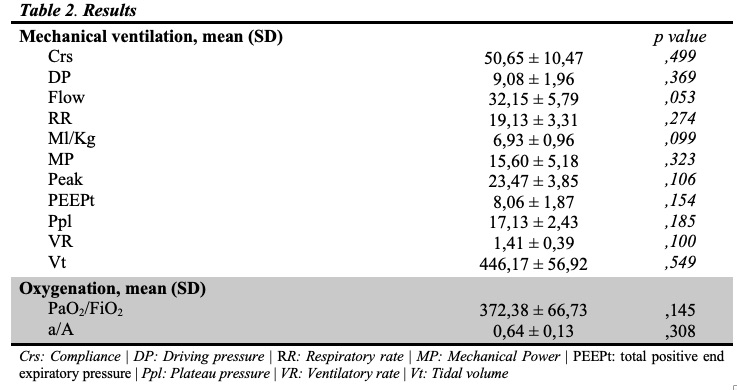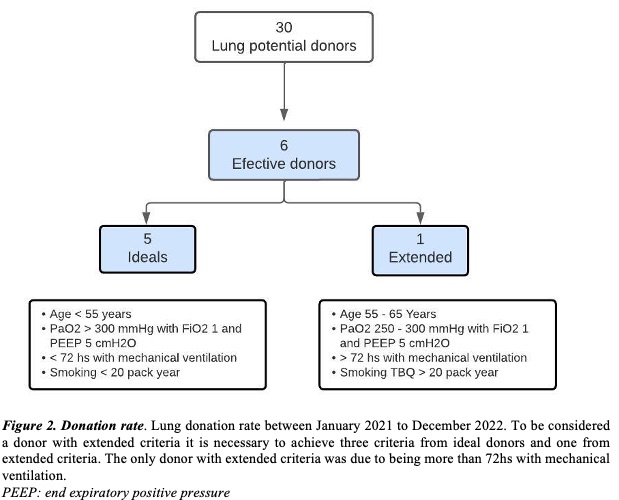Descriptive analysis of mechanical ventilation and oxygenation in lung potential donors at ablation day
Guillermo Brunetti1, Evelyn Brizuela1, Juan Manuel Villagrasa1, Daniel Rodriguez1, Natalia Leales1, Melisa Celano1, Mauricio Petre1, Pablo Centeno1,2.
1Intensive care unit, Hospital de Alta Complejidad del Bicentenario Esteban Echeverria, Monte Grande, Argentina; 2INCUCAI, Buenos Aires, Argentina
Introduction: Organ and tissue procurement is a hospital activity aimed at meeting the demand of patients in need of transplants. Between January 2021 and December 2022, 3912 organs were procured in Argentina, including heart, lungs, kidneys, pancreas, liver, and intestines.
Following certification of brain death (BD), the deceased can be considered a potential donor (PD), unless they have medical or legal contraindications. PDs experience clinical instability, being considered critical patients, thus the goal is to ensure adequate perfusion and oxygenation of organs and tissues. Lungs are the first to deteriorate, and their management is complex due to complications secondary to BD. To be considered suitable for procurement, among other requirements, a PaO2/FiO2 > 300 is needed. Achieving these goals requires the application of a protective ventilation strategy, where the role of the physiotherapist comes into play, being responsible for applying assessment tools, treatment, and respiratory care procedures.
The aim of this study was to describe ventilatory mechanics and oxygenation variables in potential lung donors on the day of organ procurement. Additionally, the secondary objective was to analyze the lung donation rate within the study sample.
Methods: Retrospective, cross-sectional, observational study design. Potential lung donor patients with BD certification admitted to Hospital de Alta Complejidad del Bicentenario Esteban Echeverria from January 2021 to December 2022 were included. Ventilatory variables: ventilatory mode, tidal volume, respiratory rate, positive end-expiratory pressure, flow, plateau pressure, peak pressure, static compliance, resistance, driving pressure, mechanical power, and ventilatory ratio. Oxygenation variables: arterial oxygen pressure/inspired oxygen fraction (PaO2/FiO2) ratio and arterioalveolar ratio (a/A).
Results: The sample consisted of 30 potential lung donors admitted to the intensive care unit, comprising 21 (70%) males. The mean age was 38.3 years (SD 12.46). Regarding mechanical ventilation variables, PDs were ventilated between 6 and 8 ml/kg with a mean of 6.93 (SD 0.96), RR 19.13 (SD 3.31), Ppl 17.13 (SD 2.43), DP 9.07 (SD 1.96); with respect to MV days, a median of 2 (IQR 2-3) was observed. Oxygenation variables showed a mean PaO2/FiO2 of 372.38 (SD 66.73) and a/A of 0.64 (SD 0.13). The reported organ donation rate was 100% (n=30), while 20% (n=6) were effective lung donors, of which five were ideal donors and one was a marginal donor.


Conclusion: Potential lung donors received mechanical ventilation assistance according to established ventilatory support recommendations for this population; however, despite meeting ideal or marginal donor criteria, only 20% of PDs were considered suitable for lung procurement.
